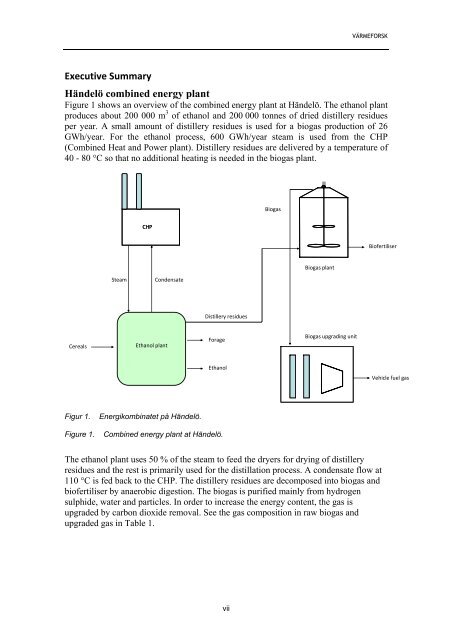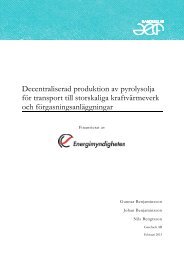Optimal integrering av energianvändningen vid ... - Gasefuels AB
Optimal integrering av energianvändningen vid ... - Gasefuels AB
Optimal integrering av energianvändningen vid ... - Gasefuels AB
You also want an ePaper? Increase the reach of your titles
YUMPU automatically turns print PDFs into web optimized ePapers that Google loves.
Executive Summary<br />
vii<br />
VÄRMEFORSK<br />
Händelö combined energy plant<br />
Figure 1 shows an overview of the combined energy plant at Händelö. The ethanol plant<br />
produces about 200 000 m 3 of ethanol and 200 000 tonnes of dried distillery residues<br />
per year. A small amount of distillery residues is used for a biogas production of 26<br />
GWh/year. For the ethanol process, 600 GWh/year steam is used from the CHP<br />
(Combined Heat and Power plant). Distillery residues are delivered by a temperature of<br />
40 - 80 °C so that no additional heating is needed in the biogas plant.<br />
Cereals<br />
Steam<br />
CHP<br />
Ethanol plant<br />
Condensate<br />
Figur 1. Energikombinatet på Händelö.<br />
Distillery residues<br />
Forage<br />
Ethanol<br />
Figure 1. Combined energy plant at Händelö.<br />
Biogas<br />
Biogas plant<br />
Biogas upgrading unit<br />
The ethanol plant uses 50 % of the steam to feed the dryers for drying of distillery<br />
residues and the rest is primarily used for the distillation process. A condensate flow at<br />
110 °C is fed back to the CHP. The distillery residues are decomposed into biogas and<br />
biofertiliser by anaerobic digestion. The biogas is purified mainly from hydrogen<br />
sulphide, water and particles. In order to increase the energy content, the gas is<br />
upgraded by carbon dioxide removal. See the gas composition in raw biogas and<br />
upgraded gas in Table 1.<br />
Biofertiliser<br />
Vehicle fuel gas




